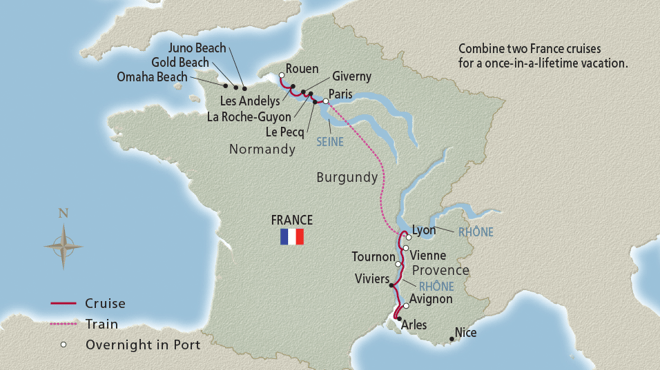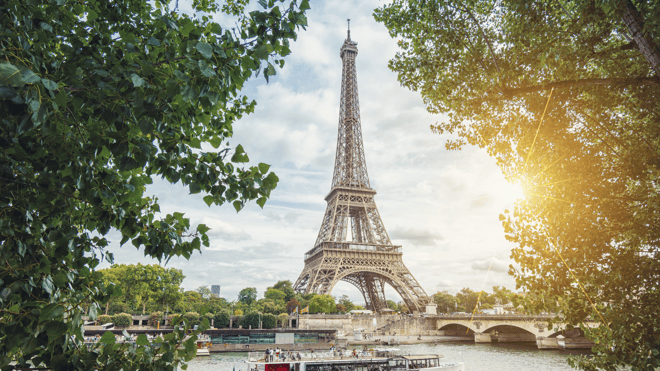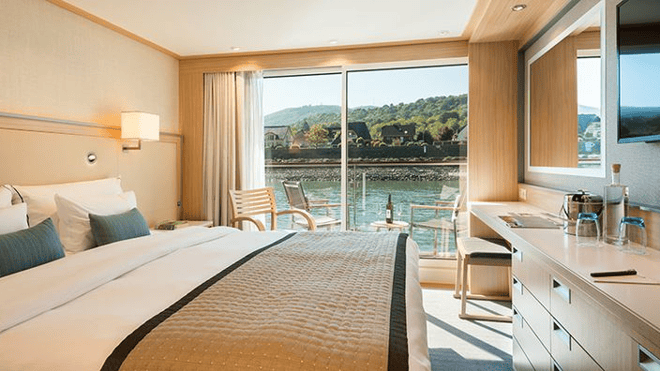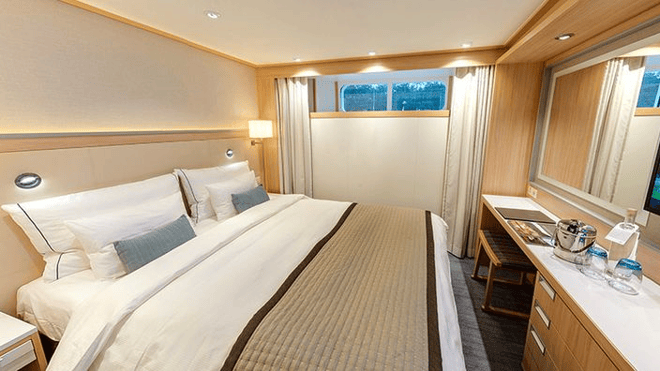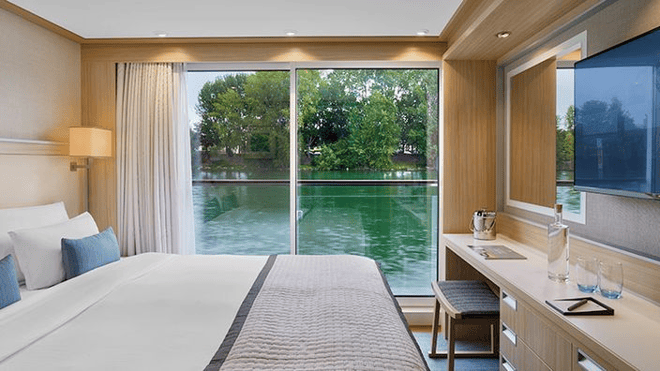French Indulgence River Cruise
Pay your respects at Normandy’s World War II beaches. Walk in Joan of Arc’s footsteps at Rouen. Luxuriate in Paris’s sophistication. Savour Lyon’s culinary heritage. Toast the Beaujolais vineyards. Explore Avignon’s Palace of the Popes. Celebrate the Provençal lifestyle.
- One complimentary shore excursion in every port of call
- Free Wi-Fi (connection speed may vary)
- Beer, wine & soft drinks with onboard lunch & dinner
- 24-hour specialty coffees, teas& bottled water
- Port taxes & fees
- Ground transfers with Viking Air purchase
- Visits to UNESCO Sites
- Enrichment lectures & Destination Performances
- Onboard gratuities
ALL STATEROOMS INCLUDE:
- Outside staterooms with river view
- Bottled water replenished daily
- Voltage: 220V & 110V (US outlet), plus USB ports
- Queen-size Viking Explorer Bed with optional twin-bed configuration
- All Upper & Middle Deck staterooms have a full veranda or French balcony (a floor-to-ceiling sliding glass door)
- Private bathroom with shower; heated floor & anti-fog mirror; premium Freyja toiletries; robes & slippers (upon request)
- 40" or 42" flat-screen Sony® TV with infotainment system featuring Movies On Demand, plus CNBC, CNN, FOX & more
- Telephone, safe, refrigerator, hair dryer & individual climate control
- *All amenities on board Viking Longships; amenities vary on other ships.
Your fare excludes:
- Flights & travel insurance
Day by Day - Paris to Avignon
Day 1 - Paris, France
Embark your ship and settle into your stateroom. Long a hub of French culture and cuisine, Paris is one of the most romantic destinations in the world. Over the centuries, Parisian culture has been built on the wings of inspiration. Music, film, architecture, literature, dance and the visual arts all have their brilliant place in the museums, theaters, bookstores and remarkably preserved buildings of this magnificent city. At the center of it all is the Champs-Élysées. With its inviting riverside promenade, graceful bridges and splendid views of all things Parisian, from the Eiffel Tower to the Louvre Museum.
Day 2 - Paris, France
One of the most pleasurable activities in Paris is whiling away the time in one of the city’s outdoor cafés. Whether you are sipping a café au lait or a kir royal, there is no better way to feel like a Parisian. The hub of social and culinary life, cafés have been part of the city’s fabric since the 1600s. During the 20th century, literary and artistic figures—such as Ernest Hemingway, Colette and Pablo Picasso—famously met over drinks to share their works and ideas. Today, thousands of cafés line the pavements and squares to connect with France’s culture and history.
Day 3 - La Roche-Guyon & Vernon, France
The picturesque village of La Roche-Guyon lies within the verdant Vexin Français Regional Nature Park, bound between the meandering Seine River and a striking wall of white chalk. This idyllic setting is home to a number of historic monuments, including a 15th-century church dedicated to St. Samson; a 16th-century salt store; a public fountain presented to the village in 1742; and the town hall, inaugurated in 1847. The beguiling 12th-century Château de La Roche-Guyon, however, is undoubtedly the village’s most emblematic landmark, once capturing the attention of poet Victor Hugo, impressionist Claude Monet and composer Joseph Kosma, among many others. The castle and its breathtaking surroundings still mesmerize all who visit it.
Day 4 -Seime River
The Seine meanders through the mellow vistas of Normandy. As it makes its sleepy and serpentine way to the English Channel, it winds along for 240 miles from Paris, more than doubling the distance of a crow’s flight. As you sail, fertile fields unfurl toward groves of apple orchards, sources of the region’s famed calvados apple brandy. Norman cows graze the grassy meadows that help produce creamy Brie and Camembert. You will also gaze upon picturesque villages and historic abbeys on these bucolic banks.
Day 5 - Normandy Beaches
History focused its sights along the coast of Normandy, France—notably Omaha, Juno and Gold Beaches—on the early morning of June 6, 1944, as American, Canadian and British troops made landfall in their first European incursion during World War II. The entire operation was termed Operation Overlord, the code name for the invasion of Normandy. The remains of the concrete structures and steel causeway of Mulberry Harbor, built by the British, can still be seen on the beach near the village of Arromanches. The Arromanches Debarkment D-Day Museum presents animated 3D scale models to help visitors grasp this exceptional harbor and its contribution to the battle—considered perhaps the single greatest innovation that ensured victory for the Allies.
Day 6 - Les Andelys, France
Les Andelys is best known for its imposing castle overlooking the city, the Château Gaillard. Built in 1196 by Richard the Lionheart, the castle and the village’s strategic location bolstered the importance of Les Andelys throughout the Middle Ages. The town also gained notice for its Sainte Clotilde Miraculous Spring, where the wife of the first Frankish king, Clovis, turned well water into wine to serve the builders of her Benedictine monastery. Europe’s devout, upon hearing of the act, flocked here on pilgrimages until the end of the 19th century.
Day 7 - Le Pecq & Paris, France
Long a hub of French culture, cuisine and architectural splendor, Paris is one of the most romantic destinations in the world. Over the centuries, Parisian culture has been built on the wings of inspiration. Music, film, architecture, literature, dance and the visual arts all have their brilliant place in the museums, theaters, bookstores and remarkably preserved buildings of this magnificent city. At the center of it all is the Champs-Élysées. With its inviting riverside promenade, 37 graceful bridges and splendid views of all things Parisian, from the Eiffel Tower to the Louvre Museum, it is France’s most beautiful boulevard.
Day 8 - Paris, France
After breakfast, disembark your ship and transfer to your embarkation city. During World War II, occupied Paris became the center for the Free French resistance movement. Unlike other French cities that were targets of Allied bombing raids, Paris escaped major damage and its many iconic landmarks, such as the Eiffel Tower and the Louvre, survived the war intact and can still be enjoyed today. Liberation came just two months after the D-Day landings in Normandy, when divisions of the French tanks and US infantry entered the city on August 26, 1944, culminating with an exuberant march, led by Gen. Charles de Gaulle, down the Champs-Élysées.
Day 9 - Lyon, France
Lyon is known as the food capital of France. It is not uncommon for well-heeled Parisians to travel to Lyon for dinner. The city is surrounded by towns and villages that produce excellent fresh produce, and gastronomic outlets are plentiful here. The great chefs of Lyon enjoy celebrity status, whether they prepare classic recipes the traditional way or elevate them with their own signature touches. Their delicious meals may be paired with a glass of light, fruity Beaujolais from the north or a bold Rhône red from the south.
Day 10 - Lyon, France
One of Europe’s densest concentrations of urban Renaissance buildings, Old Lyon is pure pleasure to explore. The dwellings of this UNESCO site date back to the city’s silk weaving success during the 15th century, when Italian merchants and bankers put their profits into building town houses; today some of their elegant residences house museums. St. Jean Cathedral lies in the heart of Old Lyon and is a stunning example of Romanesque and Gothic architecture. It has weathered periods of political turmoil and religious wars and is now one of the city’s most prominent symbols.
Day 11 - Vienne & Scenic Sailing: Rhone River
Situated between France’s Burgundy and Beaujolais regions, Vienne is the gateway to Lyon’s countryside. It is one of the oldest towns in France, with a history that can be traced through its architecture. Among its Roman remains and artifacts, the Roman Temple of Augustus & Livia dates back to the 1st century AD. Its Roman amphitheater, nestled in the hills of Mont Pipet, is one of the best preserved in the nation. Vienne also boasts remarkably preserved medieval buildings and market ruins. Other landmarks include the Abbey of Saint Pierre and the Church of Saint-André-le-Bas.
Day 12 - Tournon, France
Tournon lies secluded between the river and the vineyard-blanketed granite slopes that nurture fine vintages. An ancient castle, built snugly into a rock, overlooks the riverside setting. A settlement has perched on this hill since Celtic times, but the stunning views from its overlook have never changed. The name of its neighboring wine-producing region, Tain-l’Hermitage, comes from the hermit who planted vines here after returning from the Crusades. Today, his vines are awash in sunshine and produce a port-like wine and some stellar whites.
Day 13 - Arles, France
In the last days of the Roman Empire, Arles was the capital of Roman Gaul and boasts many Gallo-Roman ruins including Les Arènes; this ancient amphitheater seats 20,000 and is still used today for bullfights and plays. The town has an energetic feel, attracting farmers from the countryside to the frequent and famous Provençal market. It also enjoys a rich artistic heritage; the Mediterranean sunlight here inspired legendary Impressionist Vincent van Gogh to paint a number of works. Many of Arles’s sights are immortalized in his paintings.
Day 14 - Avignon, France
Avignon’s narrow streets are lined with churches and remarkable medieval buildings. This “City of Popes” was the papal seat for 70 years during the 14th century after the sitting pope abandoned Rome and fled here. The massive church-fortress Palais des Papes, or Palace of the Popes, was the center of the Christian world during that controversial period. It remains a work of Gothic splendor. Another of Avignon’s notable structures reaches into the Rhône, the ruins of the Pont d’Avignon. The 12th-century bridge, immortalized in folk song and dance, once spanned the river.
Day 15 - Avignon, France
When the Catholic Church acquired Avignon during the 1300s, it quickly transformed the quiet riverside village into a major religious and cultural center. Evidence of the makeover is everywhere. In addition to the enormous palace, the church constructed a wall around Avignon and provided mansion-like residences to its cardinals. Avignon Cathedral was dwarfed by its neighbor, the Palace of the Popes. Centuries after the papacy returned to Rome, the Vatican called for a gilded statue of Mary to be placed atop the cathedral; her golden gaze still welcomes visitors today. After breakfast, disembark your ship and journey home.
Itinerary subject to change without prior notice.
Multiple departure available from March 2025 to November 2026
Below price based on departure on 2 April 2025, Avignon to Paris on the Viking Hermond.
- Standard (F) from $11,895 pp twin share*
- Standard (E) from $12,095pp twin share*
- French Balcony (D) from $15,295 pp twin share*
- Veranda (B) from $17,295 pp twin share*
- Veranda (A) from $17,695 pp twin share*
- Explorer Suite (ES) from $32,295 pp twin share*
For pricing on alternative departure dates, please call our team on 1300 414 198 today!
*Prices and category availability are subject to change without notice.
STANDARD STATEROOM (E, F)
- Stateroom size: 150 sq ft
- River-view stateroom with half-height picture window
- 12 PM Embarkation
- Queen-size Viking Explorer Bed (optional twin-bed configuration) with luxury linens & pillows
- Free Wi-Fi (connection speed may vary)
- 42" flat-screen TV with infotainment system featuring Movies On Demand, CNBC, CNN, FOX & more
- 110/220 volt outlets & USB ports
- Private bathroom with spacious glass-enclosed shower, heated floor, anti-fog mirror & hair dryer
- Premium Freyja® toiletries
- Plush robes & slippers (upon request)
- Telephone, safe, refrigerator
- Individual climate control
- Bottled water replenished daily
- Stateroom steward & twice-daily housekeeping
- Under-bed suitcase storage space
- Roomy wardrobe with wooden hangers
FRENCH BALCONY STATEROOM (C, D)
- Stateroom size: 135 sq ft
- River-view stateroom with French balcony (floor-to-ceiling sliding glass door)
- 12 PM Embarkation
- Queen-size Viking Explorer Bed (optional twin-bed configuration) with luxury linens & pillows
- Free Wi-Fi (connection speed may vary)
- 42" flat-screen TV with infotainment system featuring Movies On Demand, CNBC, CNN, FOX & more
- 110/220 volt outlets & USB ports
- Private bathroom with spacious glass-enclosed shower, heated floor, anti-fog mirror & hair dryer
- Premium Freyja® toiletries
- Plush robes & slippers (upon request)
- Telephone, safe, refrigerator
- Individual climate control
- Bottled water replenished daily
- Stateroom steward & twice-daily housekeeping
- Under-bed suitcase storage space
- Roomy wardrobe with wooden hangers
VERANDA STATEROOM (A, B)
- Stateroom size: 205 sq ft (includes private veranda)
- River-view stateroom with floor-to-ceiling sliding glass door opening to full-size veranda
- 12 PM Embarkation
- Queen-size Viking Explorer Bed (optional twin-bed configuration) with luxury linens & pillows
- Free Wi-Fi (connection speed may vary)
- 42" flat-screen TV with infotainment system featuring Movies On Demand, CNBC, CNN, FOX & more
- 110/220 volt outlets & USB ports
- Private bathroom with spacious glass-enclosed shower, heated floor, anti-fog mirror & hair dryer
- Premium Freyja® toiletries
- Plush robes & slippers (upon request)
- Telephone, safe, refrigerator
- Individual climate control
- Bottled water replenished daily
- Stateroom steward & twice-daily housekeeping
- Under-bed suitcase storage space
- Roomy wardrobe with wooden hangers
How will payments on board be handled?
Although most services are included in your cruise fare, discretionary purchases will be charged to your shipboard account. These accounts, along with all prices and currency on board the ship, are as follows:
- Europe: euro
- Mekong: US dollar
- Egypt: Egyptian pound
- Mississippi, United States: US dollar
Accounts may be settled in cash or with a major credit card before disembarking the ship; traveler’s checks are not accepted.
Is there Internet access on board the ship?
All ships sailing our Europe, Egypt and the Mississippi itineraries offer free Wi-Fi. Our connection relies on a cellular or satellite terminal—the best possible solution for river cruising.
What is the dress code?
During the day, dress is casual including shorts (if the season is warm), slacks or jeans and comfortable shoes for walking tours. There are no “formal nights” in the evening; recommended evening dress is “elegant casual.” For ladies, this may include a dress, skirt or slacks with a sweater or blouse; and for gentlemen, trousers and a collared shirt. A tie and jacket are optional.
Some shore excursions visit religious sites that require modesty of dress. To avoid being denied entry, we recommend men wear long pants and refrain from sleeveless shirts; and for women, clothing that covers the knees and tops that are not sleeveless or too revealing.
What is the tipping policy?
From the Program Director and Hotel Manager to restaurant servers and housekeeping, the onboard staff is dedicated to serving you. Gratuities are included on board. Any additional tipping is at your discretion; should you choose to tip your local guides and drivers, we recommend tipping at the end of each tour in cash. Most restaurants include service in their prices, and it’s customary to round up generously for good service.
Travel at 60 and supplier booking conditions apply.
Fly Cruise Offer - Fly Free up to AU$2,300 per person when booked by 15 November 2024. Terms & Conditions apply.
- Prices are per person, in Australian dollars, based on double occupancy and correct at time of printing. Prices include all advertised discounts and all offers are subject to availability and may be withdrawn at any time. All offers are only valid for new bookings and only on selected departures unless sold out prior.
- A non-refundable deposit of AU$1,000 per person is required to secure a confirmed reservation within 3 days of booking otherwise the reservation may automatically cancel.
- GERMAN RIVERS Value Added Tax (VAT).
SUPPLIER FLIGHT OFFER TERMS AND CONDITIONS
- Fly Free is economy flight(s) for both guests up to the value of AU$2300 per person (pp) to/from Australia/New Zealand.
- If the flight cost exceeds AU$2300pp the guest will cover the difference.
- If flights are cheaper than AU$2300pp the unused portion of the air funds will be waived. Cannot be transferred towards any other portion of the booking or any other person.
- A guest can use the AU$2300pp to instead upgrade to business class or premium economy with the difference to be covered by the guest.
- Any flight cost difference is to be paid at the time of flight booking.
- Flights are supplier's choice of airline for selected major gateways in AU/NZ: ADL/AKL/BNE/CBR/CHC/CNS/DRW/HBA/LST/MEL/OOL/PER/SYD/WLG.
- Guest must return their air form within 14 business days of receiving request for flights, otherwise supplier reserve the right to remove the free air promo and apply the respective in lieu of flights discount.
- Valid on bookings made between 01 August 2024 – 15 November 2024.
- Guest may not request to change to flights included promotion post campaign end date of 15 November 2024.
- Viking will reach out to you or your travel advisor once flights are in the date range, at this point you may nominate your preferred in / out dates.
- Both guests must be on the same airline booking (PNR) and fly together in both directions.
- Solo guests for River can use up to AU$4600 towards their flights. Any unused portion of the air funds will be waived and cannot be transferred towards any other portion of the booking or any other person or booking.
- Please use code FFR23 to activate the Fly Free offer when booking online or via the Contact Centre.
